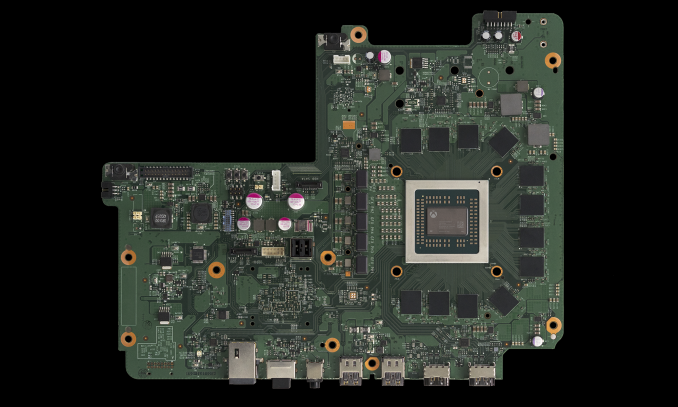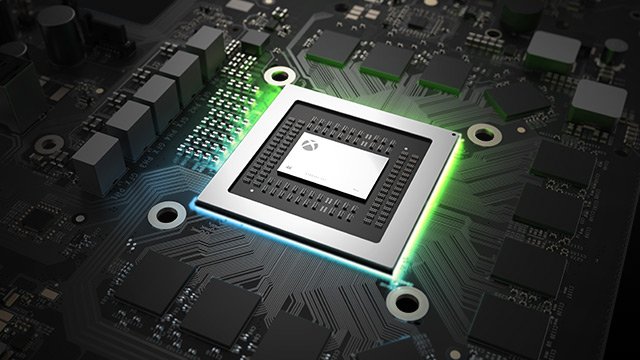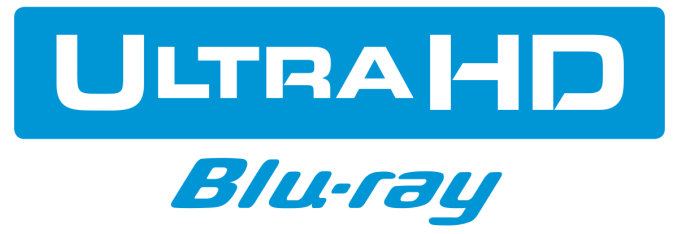The Xbox One X Review: Putting A Spotlight On Gaming
by Brett Howse on November 3, 2017 3:01 AM EST- Posted in
- Consoles
- Microsoft
- Xbox One
- Xbox
- Xbox One X
Powering Xbox One X: The Scorpio Engine
The heart of the Xbox One X is a custom AMD APU, which Microsoft is dubbing the Scorpio Engine. This APU features eight CPU cores and forty GPU compute units, essentially making it a vastly more powerful version of the APU found in the original Xbox One. All of this is built on TSMC’s 16 nm fab process, packing seven billion transistors into 360 mm2. Amazingly, that’s almost exactly the same size die as the original Xbox One, although quite a bit larger than the 240 mm2 of the Xbox One S, which is also built on TSMC 16 nm. Thanks to quite a bit of disclosure from Microsoft between the time the Xbox Project Scorpio was announced, until the launch of the Xbox One X, we know quite a bit about what’s powering the latest console.
 Image Source: Digital Foundry
Image Source: Digital Foundry
Eight Custom CPU Cores
The original Xbox One featured eight CPU cores based on the AMD Jaguar microarchitecture, and the Xbox One X keeps that completely intact. There’s still eight cores, and they are still based on a slightly upgraded version of Jaguar. Microsoft stated the CPU performance increased 31% over the original console, and they achieved that with a frequency bump from 1.75 GHz to 2.3 GHz.
This likely came down to several factors. They may have been able to leverage Ryzen cores, but it would have been difficult to get Ryzen into the new APU on the timelines required. Jaguar is also going to take up less of their die space as well, which is important when you are limited by your total die budget, and as we saw with the Xbox One’s eSRAM, taking die space for non-GPU functions can be a problem. Finally, since the Xbox One X will be completely backwards compatible with the Xbox One, keeping the same CPU architecture likely makes this an easier transition.
Microsoft calls these custom CPU cores, and while we’ll likely never get all of the information on what’s custom on them, Microsoft has released a couple of details. In particular, these new CPU cores implement a page descriptor cache of nested translations, which is a fairly low level optimization to the cache design that allows Microsoft to offset some of the remaining overhead that comes from their use of virtual machines by better caching the VM's memory operations. This optimization gets the Scorpio Engine a few percent more in average CPU performance. But regardless, the custom x86 CPU is 31% faster than the original Xbox One thanks to a 31% higher frequency. Clearly the team’s testing and research showed that this was enough CPU for the expected requirements.
12 GB GDDR5 System Memory
Arguably the biggest change to the Xbox One X is the move from 8 GB of DDR3 with a 32 MB eSRAM buffer, to 12 GB of GDDR5 memory, clocked at 6.8 Gbps. This isn’t just because there’s more RAM, but more because it gets rid of the eSRAM. The Xbox One X has twelve 32-bit channels for the GDDR5, resulting in a 384-bit memory interface. Coupled with the 6.8 Gbps data rate, that provides 326 GB/s of system memory bandwidth. 9 GB of RAM is available to developers, with 3 GB reserved for the system to handle multi-tasking. The original plan for a 4K dashboard got dropped to provide more RAM to developers, so the 3 GB matches the same reservation as the original Xbox One console.
The original Xbox One had just 68.3 GB/s of system memory bandwidth, and compensated with a 102 GB/s bi-directional eSRAM buffer. The Xbox One X no longer requires that buffer, thanks to copious amounts of bandwidth for main memory, which frees up a lot of die space on the APU. I wonder what they’ll use that space for?
40 GPU Compute Units at 1172 MHz
Microsoft was able to invest almost all of the free die space from the removal of the eSRAM into improving the GPU. The Xbox One X ships with the most powerful GPU in any console, and features an AMD custom GPU.
The heart of the Xbox One X is a GPU that's roughly based on AMD’s GCN 4 (Polaris) architecture. It offers 40 compute units, 2560 stream processors, and 32 ROPs. For comparison, an AMD Radeon RX 480 offers 36 CUs, so the Xbox One X offers 11% more compute hardware than the RX 480. Compared to the PlayStation 4 Pro, the Xbox One X offers about 43% more shader throughput.
There’s of course more custom blocks here as well. A console designed for 4K and HDR still needs to work with SDR 1080p displays, and the Xbox display controller can supersample down from 4K to 1080p, or even 1440p, as needed. There’s media blocks for HEVC as well, to handle the 4K video requirements for Blu-Ray and streaming, and the Xbox Game Capture can also capture at 4K now.
Storage: SATA HDD
For those hoping for all flash based storage in their console, those days are still a long way off. The amount of storage needed for games, especially those with 4K assets, is copious, to say the least, so for now we’re stuck with spinning disks. Digital Foundry reports that the Xbox One X will have 50% more bandwidth to the hard drive, which likely means the latest model is finally SATA III, rather than SATA II, for the 2.5” HDD. Unlike the short lived Xbox One Elite, there doesn’t appear to be any SSHD options at this time.
If you need extra storage, the Xbox One supports external USB storage. It would be nice if Microsoft had made it possible to replace the internal storage easily, but so far, they don’t seem to want to do that. Adding external storage is pretty simple though.
UHD Blu-Ray
Like the Xbox One S, the Xbox One X ships with a UHD Blu-Ray drive, allowing you to play UHD/4K movies with HDR support. There’s no support for Dolby Vision currently.
Hardware Summary
There’s a lot of performance packed into the new Xbox One X. Microsoft was too conservative with the original Xbox One, and they seem to be out to prove that they won’t make that mistake again. This is a console designed to target 4K right from the start. As to how successful they will be, that will depend on the developers, and the ever-evolving trade-off between more complex scenes, and higher resolution, but with a GPU that is almost five times more powerful than the original Xbox One, coupled with 12 GB of 384-bit GDDR5, and a faster CPU, the aim looks like its on target.













128 Comments
View All Comments
abrowne1993 - Friday, November 3, 2017 - link
Wow, surprised to see a console review here. And before it even launches, at that.yhselp - Friday, November 3, 2017 - link
Great article. Thanks. Just one thing I didn't understand - why would XBO's DDR3 account for its performance deficit when its eSRAM buffer actually has higher bandwidth than PS4's GDDR5, albeit limited to 32 MB? I thought XBO's performance deficit comes from its weaker GPU. Can you explain, please?yhselp - Friday, November 3, 2017 - link
Ignore me, I apologize, just realized what you meant to say - that picking DDR3 necessitated an eSRAM buffer, which limited their ability to put more stuff on-chip, which resulted in a weaker GPU. Have never thought of it this way, thanks for making it clear.yhselp - Friday, November 3, 2017 - link
It's also quite ironic that by deciding against GDDR5, Microsoft essentially guaranteed that Sony would not run into production limitations with the PS4.rasmithuk - Friday, November 3, 2017 - link
I think the article is wrong here.GDDR5 was available in volume, but not in 4Gb packages (which were required to get a sensible board layout).
2Gb were available, but without going for riser cards they could only get 16 on the board, giving a limit of 4GB of RAM.
4Gb chips became available late 2012, too late for Microsoft to change the whole console design to use, but early enough for Sony (who were happy with 4GB of RAM on the PS4) to switch.
Rufnek - Monday, November 6, 2017 - link
@rasmithukYou may be entirely correct, but the reality is that Sony found a way to get GDDR5 memory in the console, with a built in power supply now less, in a much smaller space than the One Without an internal power supply. Reasoning is really that one company chose to spend real money on a compact design, and the other company was really looking to keep costs at a minimum.
novastar78 - Monday, November 6, 2017 - link
This is actually 100% correct based on the sources I've talked to.MS wanted 8GB because of the vitualized OS they wanted to give more headroom so they needed 8GB.
tipoo - Friday, November 3, 2017 - link
32MB of high bandwidth memory vs all 8GB being that bandwidth.Samus - Saturday, November 4, 2017 - link
The real problem is the SRAM just isn't much faster than GDDR5 in the first place. It only looks fast when you compare it to DDR3.Microsoft really screwed up going with DDR3. There was no excuse really. I agree with rasmithuk that the packaging they needed wasn't available for the board footprint, but that could have been worked out in the short turn (in the form of bigger initial losses on hardware sales as well) but the real head scratcher is consoles don't even use high speed GDDR5.
They use the 6-7Ghz variety. Which is not only substantially less expensive, but has never been remotely close to a "supply shortage." When you read about shortages, it's of stuff at the ultra high end. Look at 3D NAND, GDDR5X, HBM2. These all have low yields because they are new technology. GDDR5 at 8Ghz initially had low yields as well, and it was never considered for consoles, particularly because AMD has historically stayed away from 8GHz GDDR5.
StevoLincolnite - Friday, November 3, 2017 - link
No mention of how the ROPS don't align perfectly with the memory bus? Resulting in a Radeon 7970-memory like situation?